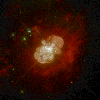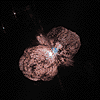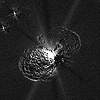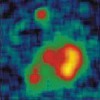 Hubble Observes a Star on the Brink of Destruction
Hubble Observes a Star on the Brink of Destruction
 Hubble Observes a Star on the Brink of Destruction
Hubble Observes a Star on the Brink of Destruction
A NASA Hubble Space Telescope "natural color" image of the material surrounding the star Eta Carinae, as imaged by the Wide Field Planetary Camera 2 (WFPC-2).
STScI-PR94-09 - September 1994
Credit: J. Hester/Arizona State University,
and NASA
 Super-Sharp View of the Doomed Star Eta Carinae
Super-Sharp View of the Doomed Star Eta Carinae
A huge, billowing pair of gas and dust clouds is captured in this stunning NASA Hubble Space Telescope image of the super-massive star Eta Carinae.
STScI-PRC96-23a - June 10, 1996
Jon Morse (University of Colorado),
and NASA
 Hubble Shows Expansion of Eta Carinae Debris
Hubble Shows Expansion of Eta Carinae Debris
The furious expansion of a huge, billowing pair of gas and dust clouds is captured in this NASA Hubble Space Telescope comparison image of the super-massive star Eta Carinae.
STScI-PRC96-23b - June 10, 1996
Jon Morse (University of Colorado),
Kris Davidson (University of Minnesota),
and NASA
 X-Rays Reveal Gigantic Star May Be Twins
X-Rays Reveal Gigantic Star May Be Twins
Eta Carinae, one of the Milky Way Galaxy's largest stars may in fact be a double star system, according to recent research by a team of astronomers using NASA's Rossi X-ray Timing Explorer (RXTE) spacecraft.
NASA RELEASE: 98-1 - January 7, 1998
Dr. Michael Corcoran, Universities Space Research Association, Columbia, MD,
Kris Davidson and Kazunori Ishibashi of the
(University of Minnesota), and NASA
![]() The Space Telescope Science Institute
is operated by the Association of Universities for
Research in Astronomy, Inc. (AURA), for NASA, under
contract with the Goddard Space Flight Center, Greenbelt, MD.
The Space Telescope Science Institute
is operated by the Association of Universities for
Research in Astronomy, Inc. (AURA), for NASA, under
contract with the Goddard Space Flight Center, Greenbelt, MD.
The Hubble Space Telescope is a project of international cooperation between NASA and the
European Space Agency (ESA).
ARVAL's Note:
With a small telescope you can observe the Keyhole Nebula in Carina,
containing Eta Carinae.
Situated some 13° West of the Southern Cross (Crux),
in-between it and the "False Southern Cross" in Carina,
it culminates at midnight on March 10.
Keyhole Nebula:
Size: 120'
Magnitude: 6.2
NGC 3372
Nebula bright with dust, plus open cluster.
R.A.: 10h 44m, Dec.: 59° 52' S (Epoch 2000)
Data from the
ARVAL Catalog of Bright Nebulas.
![]() Updated: January 9 '98
Updated: January 9 '98
Best seen with MS Internet Explorer.
Back to: ARVAL's Gallery (Eta Carinae)